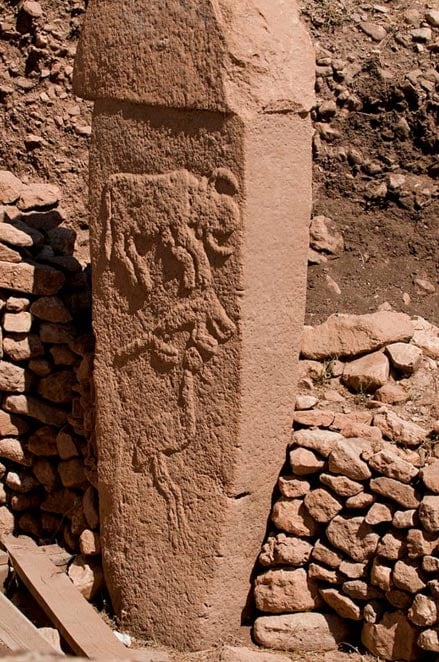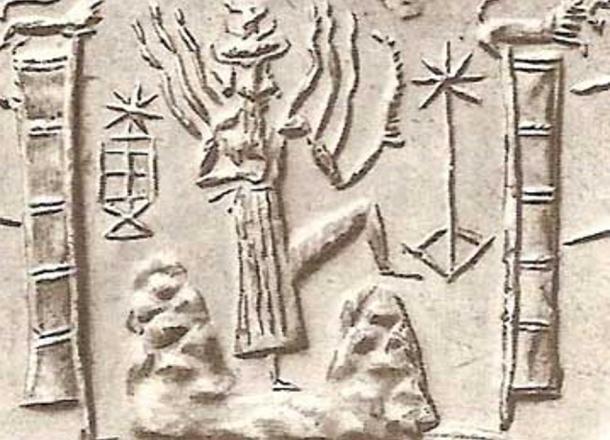
Göbekli Tepe Shamans and their Cosmic Symbols – Part I
Göbekli Tepe is an ancient and significant site which has been pushing back the beginnings of civilization further than we previously assumed. As each temple, pillar, and engraving at the Neolithic site is excavated, the story of human history is rewritten, and the symbols and messages of prehistoric cultures are revealed.
As it is understood from previous research, Göbekli Tepe was utilized as a ritual center under the control of the Neolithic shamans. Klaus Schmidt, who was the head of excavations clearly referred that Göbekli Tepe had once been the ritual center of the region. According to Schmidt, shamanic rituals were carried out in Göbekli Tepe temples, located in today's Southern Turkey.

Gobekli Tepe archaeological site. (Flickr/CC BY-NC 2.0)
Some researchers like Andrew Collins also mention the possible shamanism in Göbekli Tepe with regard to astronomy and cosmology. He approaches the subject in terms of pole star belief which we know from shamanism. Pole star is the creation point of all the universe, according to shamans. Today in Asia, Turkish, Mongolian and Tungus shamans still believe that the sky-god Tengri Ülgen ascends the throne on the pole star, Polaris.
In my opinion, Göbekli Tepe was not only the ritual center of shamans, but also the initiation center of pupil shamans. When Pillar-2 is examined closely, we clearly see bended legs of the crane. On this basis, Schmidt explains that the body of this bird may represent the human being who transforms into the crane form. Afterwards, Schmidt suggests that this phenomenon is related to the shamanism concept.
Power animals are known as the protector souls of the shaman. In the eyes of shamans, all animals are the elements of shamanic practice. The soul protects the shaman from diseases and malignancies. The shaman who gains that soul no longer cures the illnesses and prophesizes. Power animals are an “alter ego” of the shaman. Shamans imitate his or her power animal and coalesce with them during the ritual. Shamans ascend to the sky – and vice versa on land - with power animals, as they are fellow travelers.
Siberian shamans have power animals like the bear, wolf, rabbit and owl; Yakut shamans have mostly bull, eagle and bear. The forenamed animals are quite similar to the animals found carved on Göbekli Tepe pillars.

Pillar 2 from Enclosure A (Layer III) with low reliefs of what are believed to be a bull, fox, and crane. Gobekli Tepe, Urfa. (CC BY-SA 3.0)
Maybe these animals would have been the celestial constellations in the future.
In addition, a totem pole was discovered in Göbekli Tepe which we can connect with shamanism. Totemism is based on the belief of a connection between human and animals.
- The Secret of Gobekli Tepe: Cosmic Equinox and Sacred Marriage - Part 1
- The Secret of Gobekli Tepe: Cosmic Equinox and Sacred Marriage - Part II
- The Statues and Symbolic Gestures that Link Ancient Göbekli Tepe, Easter Island, and Other Sites Around the World
Shamanic Observatory
So, can we imagine that the symbols of Göbekli Tepe might have once been the symbols of shamans that were relevant to astronomy or cosmology. Was Göbekli Tepe an ancient observatory for shamans?
Some scientists (B.G. Sidharth, Giuglio Magli and A. De Lorenzis) and researchers (Joe Plegge, Andrew Collins) specify that Göbekli Tepe was used as a celestial observatory. I am asserting that Enclosure B of Göbekli Tepe was a kind of “medicine wheel” through which one can observe the birth of substantial stars or constellations.

Medicine wheels are circular stone patterns that allow us to observe astronomical objects. These sites seem to have been created with spiritual, ceremonial, and astronomical significance. Some sites are ancient, having been dated as more than 4,500 years old. In 1997, an astronomer named John Eddy from the High Altitude Observatory proposed that some of the wheels had astronomical alignments. Dr. Eddy suggested that some wheels had spokes pointing to certain stars at certain times of the year, and marked specific days of the year like solstices.
Symbolic Architecture
Göbekli Tepe pillars mainly have T-shaped forms. In New Mexico, one of the Hopi temples also has T-shaped windows, so-called Tau. As well, the Palenque Temple of the Mayans also has Tau-shaped windows. Besides, the Hopi earth-god named Masau'u has the shape of Tau. In Native American cultures, Tau symbolizes earth-bound spirits. As we can see, some of the petroglyphs of Native Americans drawn as Tau, emblematizes spiritual passageways. The “Tree of Life” represents as Tau in these cultures.

Inscriptions of the Hopi deity, Masau’u
There are two central pillars in Göbeklitepe temples. There is question on if we define these two pillars as “The Dual Divinity,” in that they should be the “celestial parents” and “male and female principles” as well. In my opinion they were for the high-priests or head-shamans of Göbekli Tepe temples. In Sumerian mythology, sun god Utu stands between two columns which symbolize a gate; and the symbols are the sky and the earth. In Greek Mythology, the two pillars of Hercules guard the passage towards the unknown.

The Sumerian deity, Utu
Beside animal motifs we see various mysterious symbols on the pillars of Göbekli Tepe temples. A “diamond-like” symbol, “H-like” and “I-like” symbol, a “three-baskets” symbol, and the “seven birds” symbol.
- The Vulture Stone of Gobekli Tepe: The World’s First Pictogram?
- Forgotten Stones: Secrets of the Megalithic Quarries
- Göbekli Tepe & The Great Year
The Diamond

It is interesting to see the “diamond-like” symbol in Göbekli Tepe. It is a new finding, having been discovered on Enclosure H pillar more recently. This sign very much resembles the “medicine man” symbol of Native Americans. A medicine man, or shaman, was believed to have magical powers of spiritual healing and foresight into the future. The outer lines of the symbol represent the four corners of the universe of the physical world: North, South, East and West. The inner lines represent the spirit world which the medicine man had knowledge of. The center circle represents the eye of the medicine man and his spiritual vision.
As can be seen, the medicine man symbol of shamans is present on Göbekli Tepe pillars. Right above this sign, one can see two snakes, and between them, an egg. Maybe this scene expresses the cosmic egg (or sun disc) and its guardians. In Hindu cosmology, the egg is the source of the universe we are living in. Maybe the two snakes represent the energies of universe or the light of the sun. Rebirth of a shaman might have been portrayed in this scene. I think this is one of the direct evidences of the shamanic fact in the Göbekli Tepe ritual center.
The Seven Birds

Again in Enclosure D we see the “seven birds” symbol. The number of seven can be evaluated as the sign of “Celestial Harmony”. According to Pueblo Natives, it symbolizes the Cosmic Harmony of the human being. Dogons consider the number seven as the symbol of the opposites, of the resolution of dualism, therefore a symbol of unicity and perfection. For Egyptians, it symbolizes the complete cycle, a dynamic perfection also representing eternal life. In Egyptian beliefs the sun god possessed seven spirits. In Turkish shamanism the earth-mountain is consisted of seven layers. The seven branches of the sacrificial and cosmic tree of shamanism is also another fact. In astronomical thinking, seven birds can symbolize the seven stars of Big Dipper of the North (seven birds on the lower base of Pillar-18 look toward a north-south direction).
We should think also of the seven visible planets that can be seen from earth with naked eye: Sun, Moon, Mercury, Venus, Mars, Jupiter and Saturn. I believe that the “seven birds” symbolize one or more of these mysterious concepts.
Göbekli Tepe Shamans and their Cosmic Symbols – Part II
Featured image: Deriv; Statue from Gobeklitepe at Urfa Museum (CC BY 2.0), Orion Nebula (CC BY 4.0), and Gobekli Tepe (Flickr/CC BY-NC 2.0)
Images courtesy author Özgür Etli.
By: Özgür Etli
References
Klaus Schmidt, Sie Bauten Die Ersten Tempel, Munchen, 2006.
Andrew Collins, The Cygnus Mystery: Unlocking The Ancient Secret Of Life's Origins In The Cosmos, 1999.
Julian Baldick, Animal and Shaman: Ancient Religions Of Central Asia, 2012.
Gary Buffalo & Sherry Firedancer, Animal Energies, 1992.
Skyways Unlimited, Medicine Wheels. WWU.edu [Online] Available at: https://www.wwu.edu/depts/skywise/medicinewheels.html
Properties of the Number 7: Symbolism. RidingtheBeast.com [Online] Available at: http://www.ridingthebeast.com/numbers/nu7.php
Egypt Gods and Goddesses, Egyptian Gods: Seshat. Egyptian-Gods.org [Online] Available at: http://egyptian-gods.org/egyptian-gods-seshat/
Ray Urbaniak, Significance Of The “T” Shape To The Ancient Anasazi, And Possible Connection To India, 2003.
Carol Diaz-Granados and James R. Duncan, The Rock-Art of Eastern North America: Capturing Images And Insight, 2004.
















Comments
Wait? does that mean that Göbeklitepe had been built by Turks?
I believe these sites were buried because the people in the area wanted to avoid the flooding they were aware of.
Interesting revelations about the number seven.
I actually wonder if it represents the All Maker, She/He/It being the first cause through utterances of existence wonderment and therefore, highly indicative of Tonal values, there being seven notes in the musical scale.
So following that, 7 universes maybe all working together to construct a being of 7 aspects, of which we may be that construction process...
So many factors reveal the 7 as being the basis of their existance....intriguing..
Hi,
My impression was that much of Göbekli Tepe was more like 8,500 BCE (or earlier) in date and that
the quality of construction was highest in the oldest and deepest excavations.
Kr
Ian
Would really like to have a plan view of the pillar layout…sadly they don’t think the angles drawn by the pillars are important so no one has ever done a detailed plan view of the site.
I have analysed one medicne circle and found it to be entirely consistent with astronomical text
http://www.midnightsciencejournal.com/2015/03/31/a-new-look-at-medicine-wheel-confirming-the-presence-of-astronomical-alignments-in-us-indian-stone-circles/
The Aubrey holes show the same data….
Gobleklie Tepe is marked in my proposed map by a secondary star located in the constellation Cygnus. This is the bird symbol mentioned in the article (the one that is etched in the stone pillar).
Part of the proposed star map (which highlights the location of Gobleklie Tepe and other ancient religious centers such as Mecca and Rome) can be seen here.
http://www.midnightsciencejournal.com/2011/11/09/the-atlantis-map-of-the...
Dr. Derek Cunningham
Author of:
The Map that Talked - How astronomy was used to map the ancient world
The Babel Texts - Decoding the early text of the Stone Age
Scotland and Shakespeare's Third Prophecy - Recovering Scotland's Forgotten past